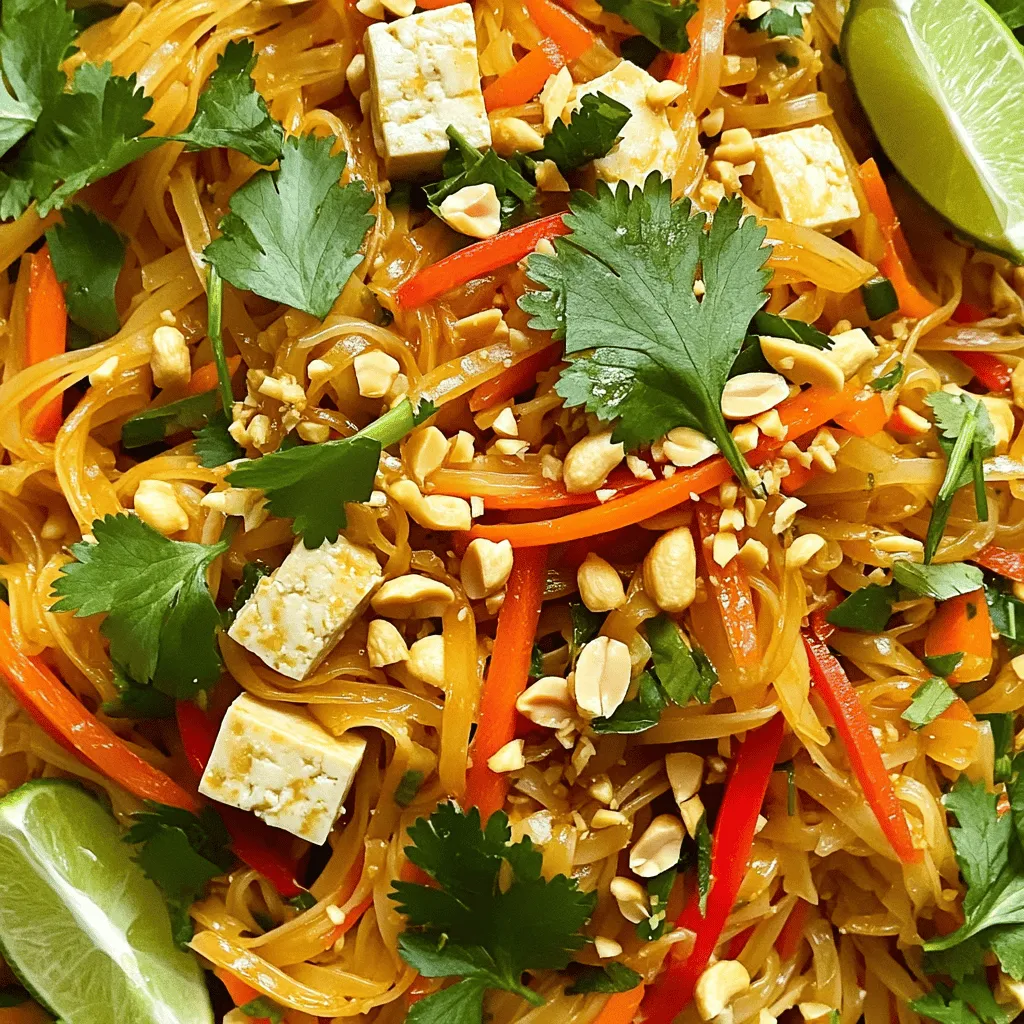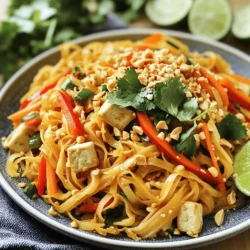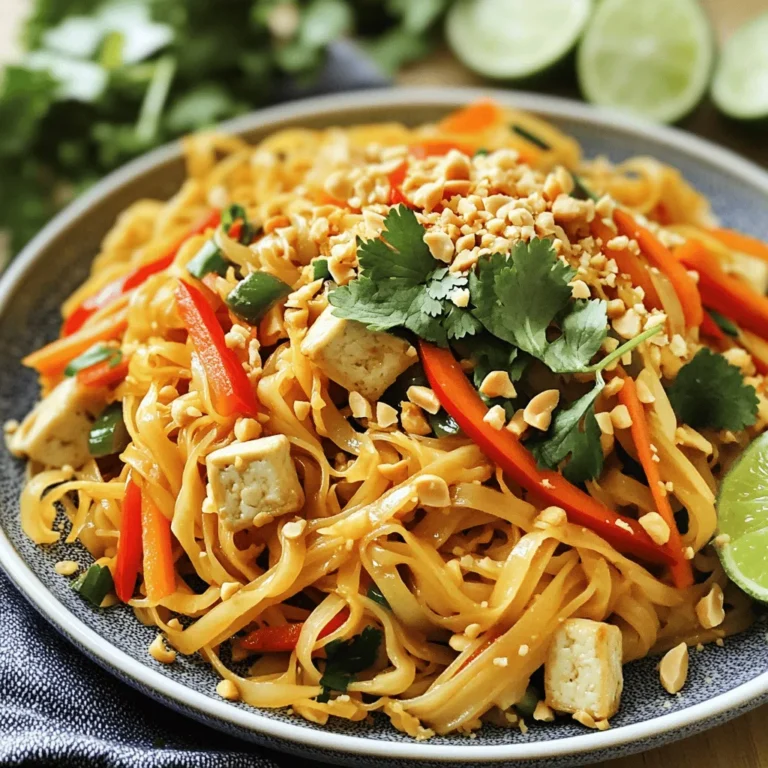Are you ready to whip up a dish that’s both tasty and easy? My Vegetable Pad Thai combines fresh veggies and rice noodles for a delightful meal. With simple ingredients, you can customize your dish to fit any taste. Whether you’re a beginner or a pro in the kitchen, this recipe will wow your family and friends. Keep reading to discover how to make this flavorful dish!
Ingredients
List of Ingredients for Vegetable Pad Thai
To make a tasty Vegetable Pad Thai, you need these ingredients:
– 8 oz rice noodles
– 2 tablespoons vegetable oil
– 1 cup firm tofu, cubed
– 2 cloves garlic, minced
– 1 cup carrots, julienned
– 1 red bell pepper, thinly sliced
– 1 cup bean sprouts
– 2 green onions, chopped
– 2 eggs, lightly beaten (optional for a vegetarian version)
– 3 tablespoons soy sauce
– 1 tablespoon tamarind paste
– 1 tablespoon brown sugar
– 1 teaspoon chili powder (adjust to taste)
– 1/4 cup crushed peanuts
– Fresh cilantro for garnish
– Lime wedges for serving
Optional Ingredients for Customization
You can change up the recipe with these optional ingredients:
– Broccoli florets for more crunch
– Snap peas for a sweet touch
– Mushrooms for an earthy flavor
– Sriracha sauce for extra heat
– Fresh basil for a fragrant twist
Nutritional Benefits of Key Ingredients
Each main ingredient adds key nutrients:
– Rice noodles provide energy from carbs.
– Tofu is high in protein and calcium.
– Carrots are rich in vitamins A and C.
– Bell peppers offer antioxidants and fiber.
– Bean sprouts are low in calories and high in vitamins.
– Eggs (if used) add protein and healthy fats.
– Peanuts give healthy fats and protein.
Using these ingredients, you create a balanced meal that is both delicious and nutritious.
Step-by-Step Instructions
How to Prepare the Rice Noodles
To start, cook the rice noodles. Follow the package instructions for the best results. Once cooked, drain them well. Rinsing them under cold water helps prevent sticking. It’s key to set them aside while you prepare the other ingredients. These noodles are the heart of your dish, so make sure they’re ready to go!
Sautéing the Tofu for Perfect Texture
Next, it’s time for the tofu. Use firm tofu for this recipe. Cut it into small cubes. Heat vegetable oil in a large skillet or wok over medium-high heat. When the oil is hot, add the cubed tofu. Sauté until golden on all sides, roughly 5-7 minutes. This gives the tofu a nice, crispy texture. Once done, remove the tofu from the skillet and set it aside. This step adds a lovely protein to your Vegetable Pad Thai.
Stir-Frying Vegetables to Retain Crunch
Now onto the vegetables! In the same skillet, add minced garlic and sauté for about 30 seconds. This will make your kitchen smell great! Next, add julienned carrots and thinly sliced red bell pepper. Stir-fry these for 3-4 minutes. You want them to start softening but still stay crunchy. This balance keeps your dish fresh and vibrant. After that, you can move on to combining everything!
Tips & Tricks
Best Practices for Cooking Rice Noodles
Start by soaking your rice noodles in warm water. This softens them before cooking. The key is to not overcook them. Follow the package instructions carefully. Drain and rinse the noodles with cold water. This helps them stay firm and prevents sticking.
How to Adjust Spice Level
To control spice, start with less chili powder. You can always add more later. Mix the chili powder with the sauce. Taste it before adding to your noodles. If you want more heat, add fresh chili slices or chili flakes. Remember, you can always adjust as you cook.
Tips for Meal Prep and Quick Assembly
Prep your ingredients ahead of time. Chop vegetables and tofu before you start cooking. Use a large skillet for quick cooking and easy mixing. Keep the sauce ready in a bowl for fast addition. This way, you can make a delicious meal in under 30 minutes.

Variations
Vegan Alternative Without Eggs
If you want a vegan version, skip the eggs. You can still enjoy great flavor. Replace eggs with extra tofu for protein and texture. Just add more cubed tofu while cooking. It will soak up the sauce nicely. This change keeps it filling and tasty.
Different Protein Options (Tempeh, Seitan)
Tempeh and seitan are great protein swaps. Tempeh offers a nutty taste. Cut it into cubes and sauté it like tofu. Seitan has a chewy texture, which some prefer. Cube it and stir-fry until golden. Both options add a nice twist to your Vegetable Pad Thai.
Seasonal Vegetable Substitutions
Feel free to mix in seasonal veggies. In spring, add snap peas or asparagus for crunch. Summer is perfect for zucchini or bell peppers. In fall, try adding pumpkin or butternut squash. Winter calls for hearty greens like kale or bok choy. These swaps keep your dish fresh and exciting.
Storage Info
How to Store Leftover Vegetable Pad Thai
To keep your Vegetable Pad Thai fresh, place it in an airtight container. This helps to lock in flavor and prevent it from drying out. Store it in the fridge for up to three days. If you notice any excess moisture, use a paper towel to absorb it before sealing the container.
Reheating Tips for Best Quality
When you’re ready to enjoy your leftovers, reheat them gently. You can use a skillet over low heat. Add a splash of water or soy sauce to keep it moist. Stir often to heat evenly. If you prefer, use a microwave. Heat in short bursts of 30 seconds, stirring in between.
Freezing Options and Duration
You can freeze Vegetable Pad Thai for later enjoyment. Place it in a freezer-safe container. Make sure to leave some space at the top for expansion. It can last up to three months in the freezer. To reheat, let it thaw overnight in the fridge. Then, use the same reheating tips as before for the best flavor.
FAQs
What is the Best Way to Make Pad Thai Sauce?
The best Pad Thai sauce blends sweet, salty, and tangy flavors. You can mix soy sauce, tamarind paste, and brown sugar. Start with three tablespoons of soy sauce, one tablespoon of tamarind paste, and one tablespoon of brown sugar. Stir this well to dissolve the sugar. You can add chili powder for a spicy kick. Taste it and adjust the flavors to fit your liking.
Can I Use Gluten-Free Noodles?
Yes, you can use gluten-free noodles! Rice noodles are a great gluten-free option for Pad Thai. Just make sure to check the package for cooking instructions. If you prefer other gluten-free noodles, look for options made from mung beans or buckwheat. These can add unique flavors and textures to your dish.
How Long Does Vegetable Pad Thai Last?
Vegetable Pad Thai lasts for about three to four days in the fridge. Store it in an airtight container to keep it fresh. You can enjoy it as a quick meal during the week. If it smells or looks off, it’s best to toss it out.
What Can I Serve with Vegetable Pad Thai?
You can serve Vegetable Pad Thai with several sides. A fresh green salad with lime dressing works well. You can also add spring rolls for extra crunch. If you want something warm, serve it with miso soup. These options will complement the flavors nicely.
Is Vegetable Pad Thai Healthy?
Yes, Vegetable Pad Thai can be healthy! It is packed with colorful veggies, protein from tofu, and healthy fats from peanuts. You control the sugar and salt by adjusting the sauce. It’s also a great way to enjoy a variety of nutrients in one dish. Eating it in moderation can fit well into a balanced diet.
In this post, we explored the flavorful world of vegetable Pad Thai. We covered essential ingredients, steps to prepare, and tips for a perfect dish. Remember, you can customize the meal with different proteins and spices. Storing leftover Pad Thai is easy, so enjoy it later! This dish is not just tasty; it’s healthy too. By following these steps, you can impress friends and family with your cooking skills. Dive into making your own Pad Thai and savor every bite!


